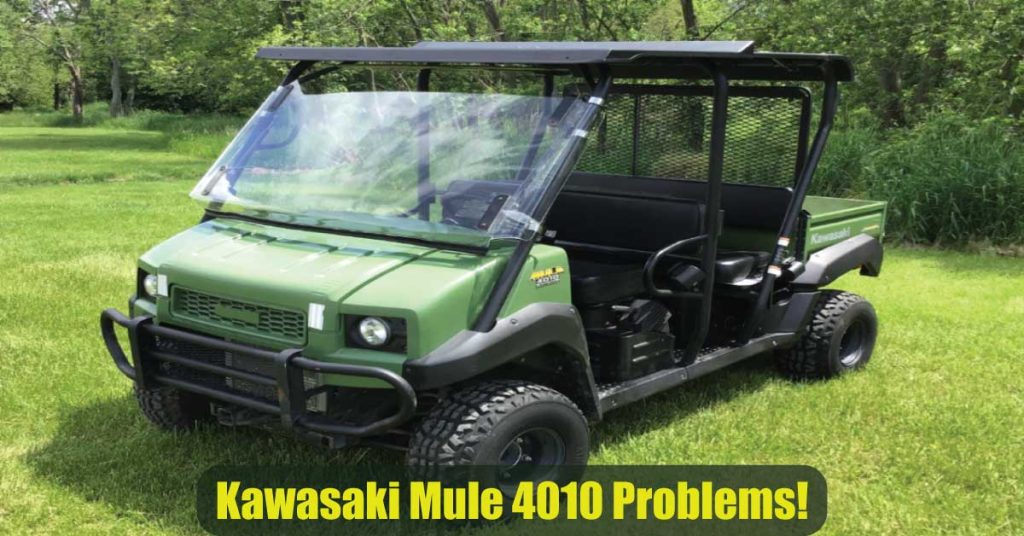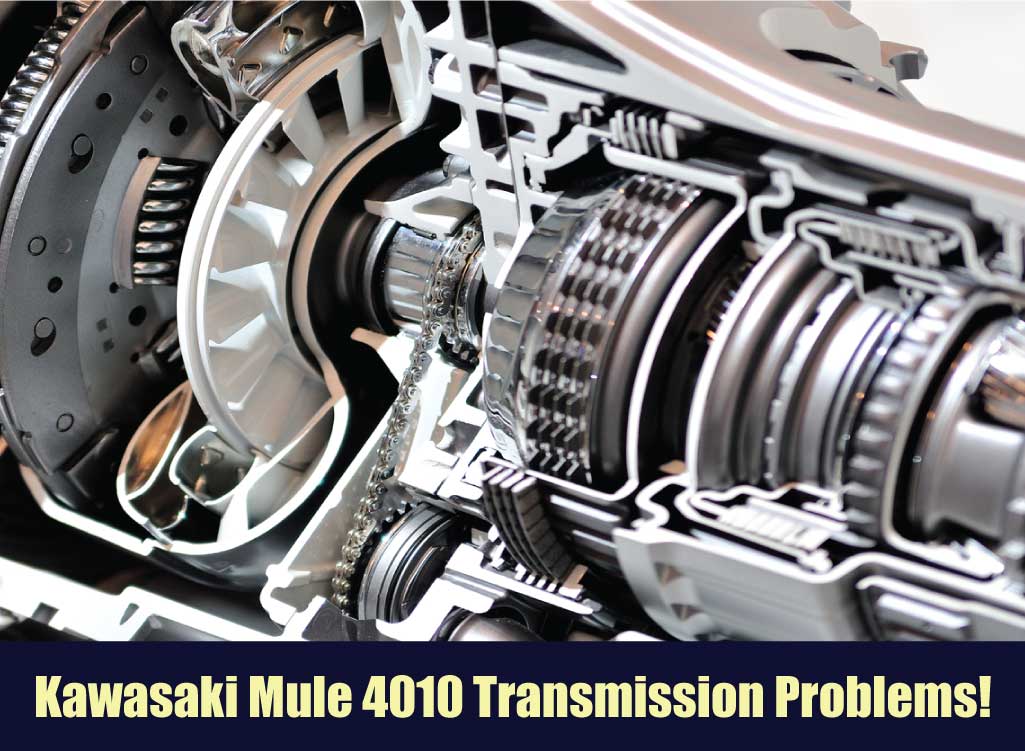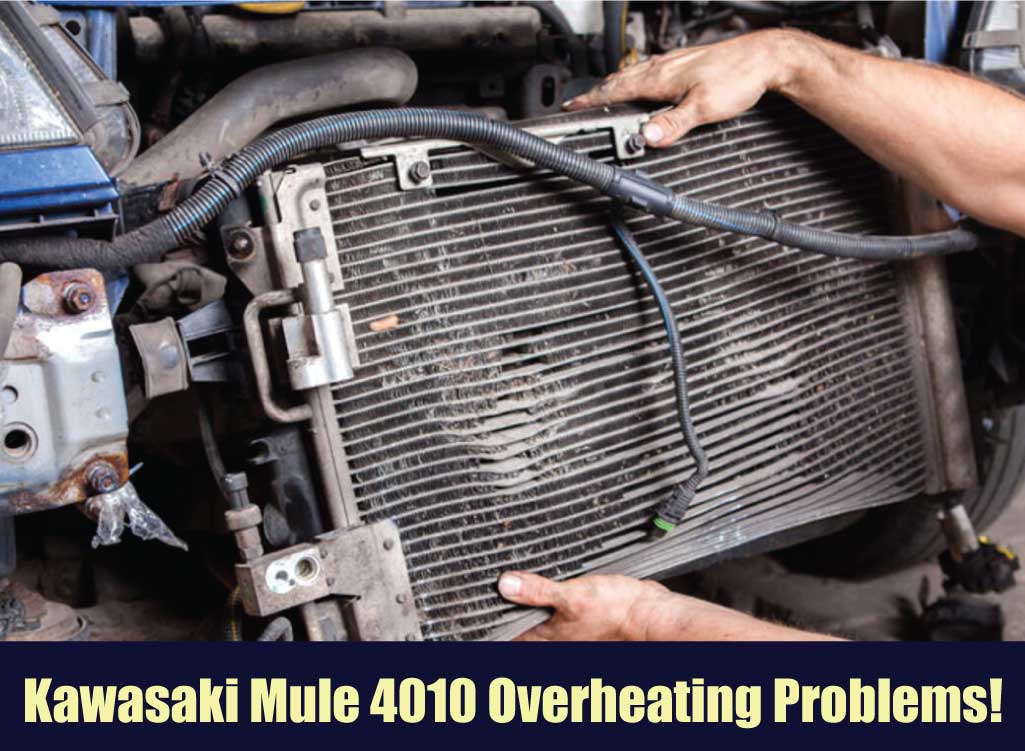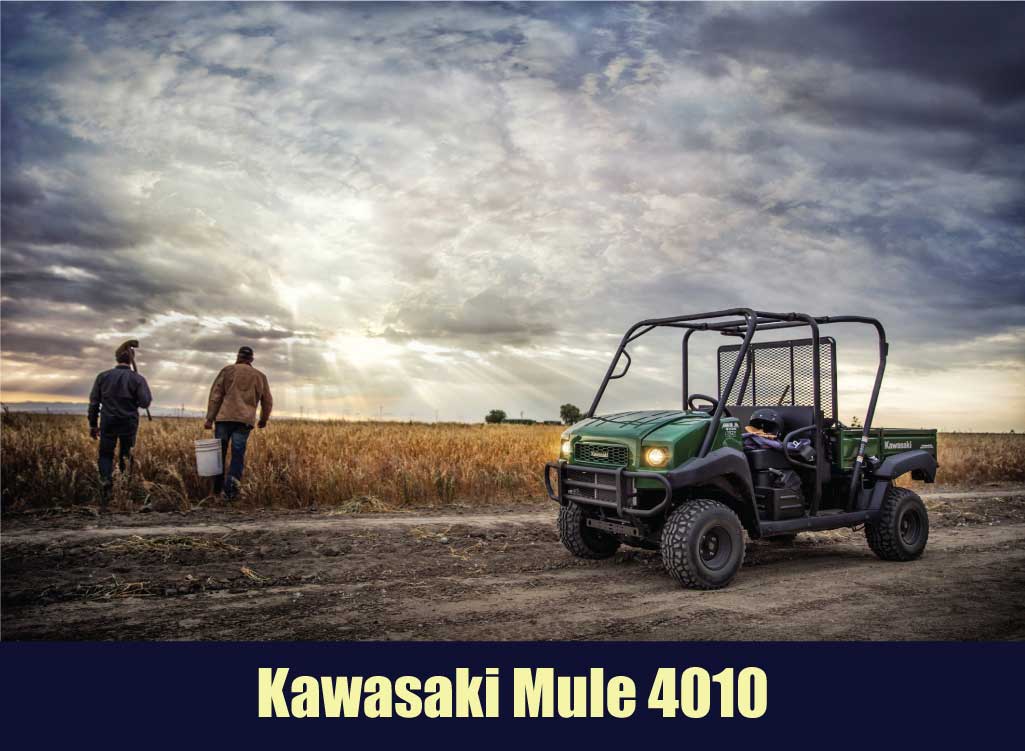
The Kawasaki Mule 4010 is a versatile vehicle that Kawasaki produces. As the least costly 4×4 utility UTV from Kawasaki, it is extremely popular due to its affordable price. Despite its low cost, you may be overwhelmed by a few Kawasaki Mule 4010 Problems.
The vehicle has an automated gearbox and a strong engine. Since its introduction in 2011, the Kawasaki Mule 4010 has seen robust sales. Despite some issues afflicting the Kawasaki Mule 4010, it continues to be a popular option among car enthusiasts. The reason is that it offers exceptional fuel economy. Also, high-performance levels at a reasonable price.
However, before purchasing one of these vehicles, there are a few Kawasaki Mule 4010 Problems that you should be aware of.
What are the most common Kawasaki Mule 4010 Problems?
- Problems with Engine Idling
- Fuel Pump Problem
- Transmission Issue
- Throttle Body and Sensor problems
- Overheating Issue
- Power loss & Steering Issue
- Braking Noise Issue
- Wire Harnesses
- Gear shifting Issue
Major Kawasaki Mule 4010 Problems and Solutions!
A clear understanding of a problem’s underlying factors can significantly simplify identifying a solution. Armed with this knowledge, you can tackle the issue independently, saving you the expense of hiring a mechanic.
If you’re working on your Kawasaki Mule 4010 and run into any problems, we’ve got you covered with a handy guide that covers the most common issues and how to solve them. It’s perfect for all your DIY needs!
Problems with Engine Idling
The vehicle’s idle problem is shown by its constant sputtering and stopping, which is typical of Mule types like the 4010. When the Mules remain idle and move slowly, the motor oil never gets hot enough to boil off the mixture of fuel, air, and waste products that get into the crankcase. This buildup can make the car hard to start.
Solution
If you’re having issues with your Kawasaki Mule’s engine idling, check the fuel quality and air filter to ensure they’re not dirty or contaminated. Also, look at the spark plug and see if it looks worn or damaged. If it does, you’ll want to replace it. Hope that helps!
Adjust the idle speed per the manufacturer’s recommendations in your owner’s manual, as improper idle settings can lead to idling issues. Verify that the throttle and choke mechanisms are functioning smoothly without any sticking, and lubricate or replace them if needed. Lastly, inspect the fuel system for any clogs or issues affecting fuel delivery to the engine. By systematically addressing these common causes, you can often resolve engine idling problems in your Kawasaki Mule.
Fuel Pump Problem
The Kawasaki Mule 4010 has quickly become a favorite among those who enjoy riding motorcycles off-road. But, like any other piece of equipment, it can break down for various reasons. Problems with the fuel pump system are widespread.
Numerous customer complaints have been made about this on the Mule 4010. An issue with the pump is brought on by a buildup of junk in the fuel filter. This obstruction may cause a lack of lubrication, which in turn results in less coolant getting to the drive motor. As a result, it may cause the drive motor and the fuel pump in the vehicle to malfunction.
Ensuring proper fuel flow is essential for optimal engine performance, as clogged filters or weak pumps can cause issues. The engine may stall or act erratically if the fuel pump pressure is too low.
Solution
Maintaining a clean and fully operational gasoline filter is crucial to avoid fuel system problems. Regularly check and replace filters to prevent supply gasoline blockages. Additionally, keep an eye on your fuel pressure every once in a while. It’s essential to ensure it’s in the proper range to keep your car running smoothly.
It’s essential to investigate any pressure that falls outside the normal range. The Kawasaki Mule 4010 motorcycle is an impressive vehicle renowned for its incredible functionality, reliability, and performance. However, it is subject to occasional breakdowns like any other vehicle. Common concerns include starting issues, low gas mileage, and technical complications like clogged fuel filters and spark plugs.
Maintaining a reliable Mule 4010 requires regular checks for damage and the proactive replacement of worn components. Investing in aftermarket warranties and roadside assistance plans can provide added security. With proper maintenance, the Kawasaki Mule 4010 can last for years without any issues.
Transmission Problem

Debris and grime buildup in the system might also result in transmission issues. Some customers report that shifting up or down is difficult when the gear stick is stuck. The difference will be apparent the moment you switch from low to high mode or high to reverse mode.
The Kawasaki Mule 4010 motorcycle is a standard pick for those searching for an off-road vehicle. Its robust construction and potent engine make it the car of choice for explorers of the vast outdoors. However, several riders have reported shifting and jerking gearbox issues with the Mule 4010.
This can be very aggravating when attempting to climb or traverse steep inclines. Several things, including old or broken parts or a lack of transmission fluid, could cause the problem. The good news is that answers exist for these issues. By replacing worn-out components or adjusting the transmission fluid level, one can achieve smoother shifting and less jerking.
Solution
If you want your Kawasaki Mule 4010 to keep running smoothly, staying on top of regular maintenance and inspections is essential. Remember to give your ride some TLC now and then! Don’t let transmission issues get you down. Plenty of preventive measures are available to keep your vehicle in top shape. Stay proactive and confident!
Taking care of your transmission is crucial to ensuring smooth performance. Regular maintenance, like changing the fluid and filter, can prevent or reduce transmission issues. Remember to inspect the components for any signs of wear and tear, as catching problems early can save you from costly repairs. Stay proactive and enjoy a worry-free driving experience!
Throttle Body and Sensor Problem
A prevalent concern that many encounters involves the throttle body and associated sensors. This situation may stem from various causes, such as insufficient engine exhaust ventilation, buildup of carbon within the throttle body, and a malfunctioning CCV (closed crankcase vent) system and throttle assembly.
However, we’re confident in our ability to address these challenges with our inventory of TPS sensor parts.
The cause of the problem with the throttle body and sensor stems from the engine exhaust being directly expelled into the air intake tubing by USEPA regulations rather than released into the surrounding environment. Consequently, the burnt oil adheres to the throttle body.
Solution
To efficiently address the problem at hand, there are a few steps you should take. Initially, it’s recommended to disconnect the tube from the TB and apply throttle body cleaner onto it while the engine is running. If the issue persists, it may be necessary to replace the part.
Over-Heating

For extreme off-road conditions, choose the Kawasaki Mule 4010 ATV. However, this durable vehicle may experience overheating issues. Clogged radiators or malfunctioning fans are the most common causes of this issue.
Unrestricted airflow into the engine compartment, which is positioned below the floor, is the root of this problem. The front seat area becomes heated as a result of the hot air passing through the air vents installed beneath the floor.
Clogged radiators prevent the proper circulation of coolant, leading to engine overheating. If the radiator is broken or not doing its job correctly, the engine’s temperature will soon rise, causing expensive damage. The motorbike’s fan is another potential source of overheating. If the fan isn’t functioning properly, the radiator won’t get enough air to keep the engine cool.
Solution
The Kawasaki Mule 4010 requires routine maintenance to avoid overheating. This requires regular maintenance, such as radiator flushing and oil and filter changes. Damage to the engine could result from overheating if the radiator became clogged.
Checking your fuel filter regularly for debris ensures optimal engine performance. If needed, replacing it promptly can prevent costly repairs. Inspect the hoses and belts thoroughly and replace them if damaged or worn out. If you follow these guidelines, your Kawasaki Mule 4010 will operate more smoothly and safely.
Power loss and Steering Problem
Unfortunately, numerous Mule 4010 customers experienced significant power loss and acceleration deterioration after using their machines for a few hundred hours.
There are several potential causes for this power outage. A blockage in the gasoline lines or a malfunctioning fuel pump are two potential causes. It could also be brought on by an improper engine spark.
The Kawasaki is a well-liked utility vehicle because it performs well in rough terrain. As a vehicle, occasional breakdowns may occur. Power steering concerns have been noted frequently by Kawasaki Mule 4010 users.
Several things, such as insufficient fluid, broken power steering lines, or a broken power steering pump, can cause these issues. If your Kawasaki 4010 has power steering issues, you should get them fixed as soon as possible. Paying attention to the case may make driving on rocky terrain easier.
Solution
However, if your power steering lines are damaged, a professional mechanic should repair them. In addition, if the front of your car got messed up, know that you won’t be able to get it completely fixed unless the frame is straightened out, too. If the Mule has difficulties stopping, you may also want to inspect and adjust the brakes.
Keeping your Kawasaki Mule 4010 in top shape requires regular maintenance. Regularly inspecting the air filter, brakes, and power steering lines is crucial for keeping your Mule healthy. Immediately fixing any issues you notice will save you time and money in the long run.
Problems of Brake Noise
Even when the brakes are not used, one might still hear a loud screeching or chirping noise. One of the most frequent problems mentioned by Mule 4010 owners is this one.
The brake dust that has accumulated on the brake pads is what causes the screaming sound you hear. The dust acts as an abrasive between the brake pads and rotors, screeching as it does so.
Solution
Replacement of the brake pads is the simplest remedy for this problem.
Wire Harnesses
Corrosion or rusting is the most typical issue with a wire harness. Corrosion happens when moisture collects in the wires, eventually making them fragile. This can occur along the wire’s length on either side, but it frequently happens where the wire reaches a connector block at the end.
Solution
You should seek the assistance of an electrician to replace the wiring harness, as it is a dangerous task that requires experience.
Gear shifting issue
Attempting to raise the gearing on your 4010 could be problematic. Especially while shifting the gears of your Kawasaki Mule up, down, or in reverse.
Many off-road vehicles have issues with gear changing. This can occur for several reasons, including manufacturer design flaws or stopped equipment.
Solution
Due to a manufacturing defect, there is no surefire fix. You can still contact them to lodge a complaint and request a resolution.
Customer’s Feedback on Kawasaki Mule 4010 Problems
Surprisingly, this model has received positive consumer feedback from around the world. The proprietors are pleased with the results. They can depend on the mule for their journeys.
Consumers indicate that the model is genuine and produced by the company. Outstanding in its durability and longevity. Their reviews also incorporated the issues. They had to resolve them without assistance from machinery.
In some instances, however, a significant number of individuals spent a substantial amount of money on repair costs.
Does Kawasaki Mule 4010 worth the Money?

The Kawasaki Mule 4010 is an off-road utility vehicle that has garnered generally excellent feedback from users and industry analysts.
Whether it is worthwhile depends on your unique requirements and intended use for the car. The Mule 4010 is well-known for its durability, dependability, and flexibility, which makes it an attractive option for farm labor, hunting, and general-purpose use.
If you’re looking for a utility vehicle that can handle rough terrain and hefty loads, the Kawasaki Mule 4010 might be worth a look.
Maintenance Guide Of Kawasaki Mule 4010!
To keep your Kawasaki Mule 4010 working well, you need regular maintenance. Maintaining your car regularly will help it run better for longer and save you money on repairs in the long run. A Kawasaki Mule 4010 motorcycle can provide a safer and smoother ride with regular maintenance.
First, you should always make sure the oil level is correct, as the engine can’t run without it. Taking your car in for an oil change every 100 hours or once a year is usually a good idea – whichever comes first. It keeps your ride running smoothly! If the engine isn’t getting enough air, it’s time to inspect the air filter and either clean it or replace it. Every 7,500 miles, or sooner if damaged, you should check the condition of your spark plugs and replace them if necessary.
Brakes, tires, and batteries are crucial parts that need regular upkeep. Ensuring optimal performance of your vehicle is easy! Regularly inspect and replace worn-out tire pressure, tread depth, brake pads, and rotors. Also, remember to keep your battery charged and avoid running it down.
Buyer’s guide: Maintain Your Kawasaki Mule 4010!
Keeping the Mule clean and free from debris is crucial, as dirt and dust can clog the engine and decrease efficiency. Regular washing and lubrication may keep the bike in good working order. If you want to keep your Kawasaki Mule 4010 motorcycle in the best condition possible, how often should you have it serviced? Your bike should be serviced after a set amount of time has passed or a certain number of miles have been traveled, whichever comes first.
Kawasaki recommends 1200 miles or six months before scheduling servicing for your Mule 4010. However, mileage, climate, and riding style can affect how often maintenance is required.
If you frequently use your bike or ride in rough conditions, you may need to maintain it more often than every three to four months or every 500 to 800 miles. On the other hand, if you use your bike less frequently or only on mild days, you can extend the time between services. If you own a Kawasaki Mule 4010, it is recommended that you check the brakes, tires, and wheel bearings every 500 kilometers.
Worn or misaligned parts should be fixed as soon as possible. Inspect it, and if necessary, replace it. All liquids, such as engine oil and radiator fluid. Ensuring the chain and sprockets are well-maintained leads to seamless and efficient operation. Last but not least, the engine needs to be checked and calibrated every few thousand miles to ensure peak performance.
About Kawasaki Mule 4010!
If you’re in the market for a dependable and compact motorbike for your off-road excursions, the Kawasaki Mule 4010 is the perfect choice with a 4-stroke, single-cylinder engine that can produce up to 24 hp and a continuously variable transmission (CVT) and 4-wheel drive. This product is engineered to navigate through diverse terrains and weather conditions effectively.
But that’s not all – the Mule 4010 also features a tilt bed for easy loading and unloading of cargo and a comfortable seat perfect for long rides. This bike is a champ when it comes to dealing with rough weather. Its water-resistant exterior makes sure it can handle anything thrown its way.
It’s no wonder that the Mule 4010 is a top pick among off-road enthusiasts. Its reliable performance and sturdy design make it the ideal companion for any adventure, whether you’re exploring the great outdoors or tackling challenging terrain.
Final Thought
In addition to its reliability and power, the Kawasaki Mule 4010 has a large payload and towing capacity. Nevertheless, it does have some issues. For you to get the most out of this model, you need to be aware of any possible hazards and take precautions to avoid them.
Troubleshooting and repairing frequent Kawasaki Mule 4010 problems can help to guarantee that it functions smoothly and safely.
If you know the potential causes of these problems, you can diagnose and resolve them more effectively. Proper maintenance is essential in keeping your mule working smoothly and avoiding potential hazards, from malfunctioning ECUs to under-seat overheating.
FAQs
What are some typical Kawasaki Mule 4010 issues?
Problems with the engine, the electrical system, the brakes, and the suspension are among the most common problems reported by vehicle owners.
How trustworthy is the Kawasaki Mule 4010?
Depending on how well it is maintained and utilized, the Kawasaki Mule 4010’s dependability can fluctuate. Many owners, however, have reported that the vehicle is dependable and durable, with some units surviving for several years.
Is the Kawasaki Mule 4010 subject to any recalls?
The Kawasaki Mule 4010 has, over the years, been subject to multiple recalls. Typical causes include fuel leakage, defective brakes, and defective suspension components.
How much does it cost to fix typical Kawasaki Mule 4010 problems?
Depending on the nature of the problem and the extent of the damage, the cost to remedy common Kawasaki Mule 4010 issues can vary. However, some proprietors have reported repair costs between a few hundred and several thousand dollars.
How can I keep my Kawasaki Mule 4010 problem-free?
To avoid problems with your Kawasaki Mule 4010, it is essential to adhere to the manufacturer-recommended maintenance schedule, perform routine inspections, and address any issues as soon as possible. Additionally, use the vehicle only for its intended purpose and drive safely and responsibly.







Leave a Reply